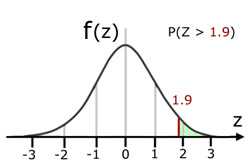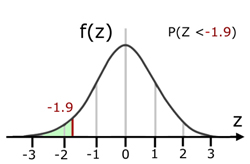Home >>STATISTICS, Section 1, normal distribution 3
first principles |
First Principles
More on z-tables
From z-tables the area under the curve of f(z) can be determined. z is read from the extreme left(- ∞) up to any positive value of z. This area Φ(z), is called the cumulative distribution function.
Hence when z = 0 the area is 0.5 . Note that the total area under the curve is 1.
If we want to measure the particular area(and hence cumulative probability) between discrete values we use a different form of the function: P(Z<z)
The case of P(Z<z)
So to evaluate P(Z<z) all we have to do is read off the value of Φ(z) for z from the tables.
Since in this case,
Φ(z) = P(Z<z)
Example
i) For a Standardized Normal Distribution N(0,1), evaluate the Cumulative Distribution Function(CDF) for the condition where z<1.9
ii) Sketch a curve to illustrate your answer.
i)
P(Z<1.9) = Φ(1.9) = 0.9713
ii) 
The case of P(Z>z)
(area under the curve to the right of any value z) =
(area under whole curve) - (area under curve up to value z)

1 - P(Z < z) = P(Z > z)
or
P(Z > z) = 1 - P(Z < z)
Example
i) For a Standardized Normal Distribution N(0,1), evaluate the Cumulative Distribution Function(CDF) for the condition where z>1.9
ii) Sketch a curve to illustrate your answer.
i)
P(Z >1.9) = 1 - P(Z <1.9)
= 1 - 0.9713
= 0.0287
ii)

The case of P(Z>-z)
By symmetry,
(area under the curve to the left of a positive value of z) =
(area under the curve to the right of a negative value of z)

P(Z<z) = P(Z>-z)
Example
i) For a Standardized Normal Distribution N(0,1), evaluate the Cumulative Distribution Function(CDF) for the condition where z>-1.9
ii) Sketch a curve to illustrate your answer.
i)
P(Z>-1.9) = P(Z<1.9)
P(Z<1.9) = Φ(1.9) = 0.9713
ii)

The case of P(Z<-z)
By symmetry,
(area under the curve to the left of a negative value of z) =
(area under the curve to the right of a positive value of z)

P(Z<-z) = P(Z>z)
from above, P(Z>z) = 1 - P(Z < z)
therefore, P(Z<-z) = 1 - P(Z < z)
Example
i) For a Standardized Normal Distribution N(0,1), evaluate the Cumulative Distribution Function(CDF) for the condition where z<-1.9
ii) Sketch a curve to illustrate your answer.
P(Z<-1.9) = 1 - P(Z <1.9)
= 1 - Φ(1.9) = 1 - 0.9713 = 0.0287
P(Z<-1.9) = 0.0287
ii)

[ About ] [ FAQ ] [ Links ] [ Terms & Conditions ] [ Privacy ] [ Site Map ] [ Contact ]
